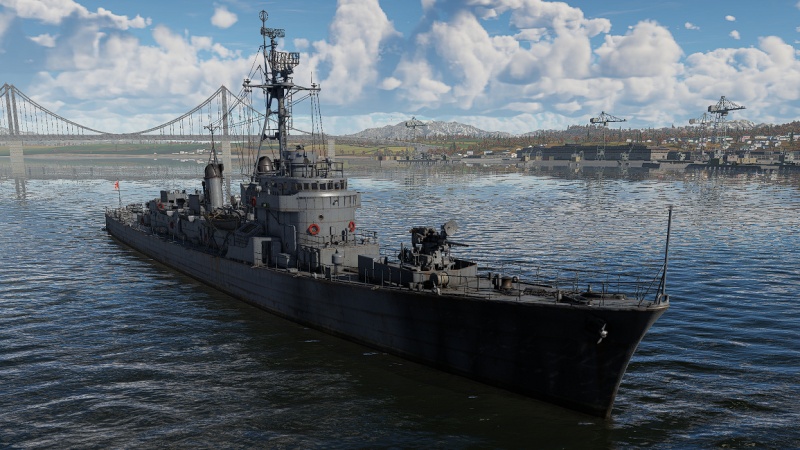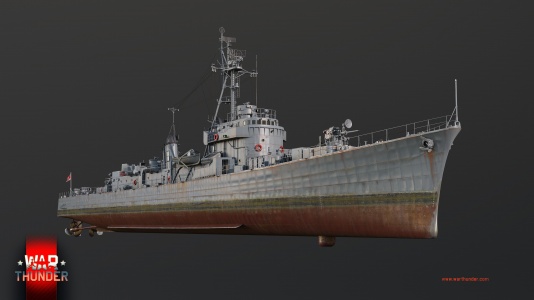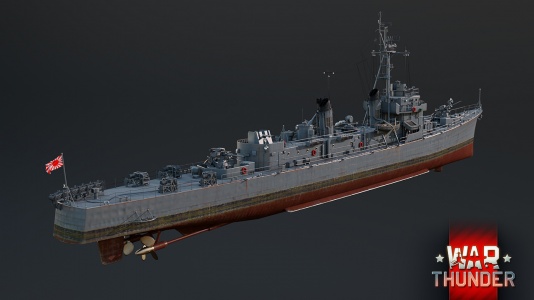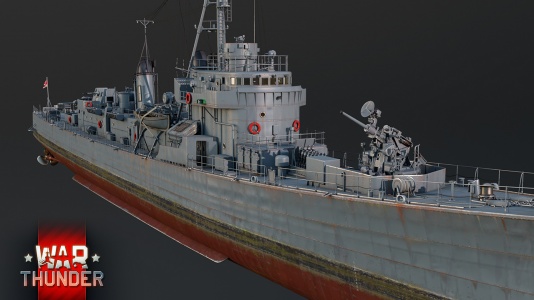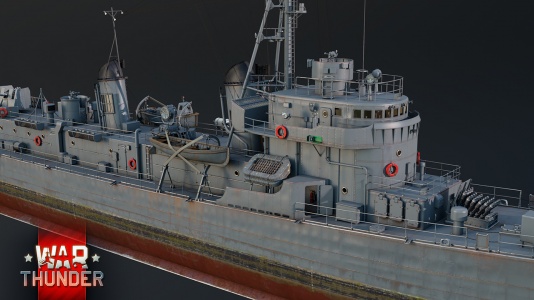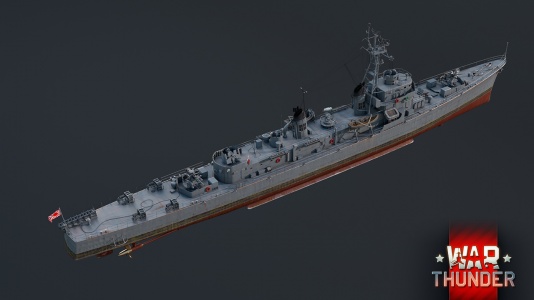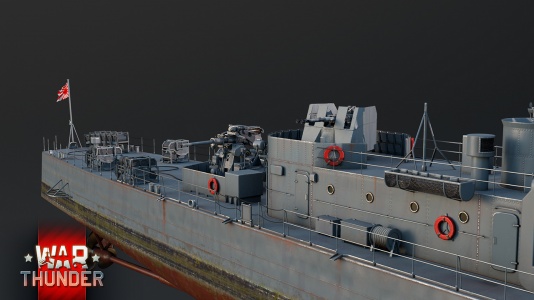Difference between revisions of "Akebono"
(Updated format) |
(fleshed out most aspects of the ship) (Tag: Visual edit) |
||
| Line 7: | Line 7: | ||
<!-- ''In the first part of the description, cover the history of the ship's creation and military application. In the second part, tell the reader about using this ship in the game. Add a screenshot: if a beginner player has a hard time remembering vehicles by name, a picture will help them identify the ship in question.'' --> | <!-- ''In the first part of the description, cover the history of the ship's creation and military application. In the second part, tell the reader about using this ship in the game. Add a screenshot: if a beginner player has a hard time remembering vehicles by name, a picture will help them identify the ship in question.'' --> | ||
The '''{{Specs|name}}''' is a premium rank {{Specs|rank}} Japanese gunboat {{Battle-rating}}. It was introduced in [[Update "Raining Fire"]]. | The '''{{Specs|name}}''' is a premium rank {{Specs|rank}} Japanese gunboat {{Battle-rating}}. It was introduced in [[Update "Raining Fire"]]. | ||
| + | |||
| + | Classified as a gunboat in-game, Akebono is one of the first domestic ship classes built by Japan after WW2. Very similar to the frigate [[Ikazuchi]], it has more crew, is faster, and at a lower BR. Akebono has high survivability owing to its large complement, and its autoloading 76 mm cannons allow for fast destruction of smaller vessels. | ||
== General info == | == General info == | ||
| Line 12: | Line 14: | ||
{{Specs-Fleet-Armour}} | {{Specs-Fleet-Armour}} | ||
<!-- ''Talk about the vehicle's armour. Note the most well-defended and most vulnerable zones, e.g. the ammo magazine. Evaluate the composition of components and assemblies responsible for movement and manoeuvrability. Evaluate the survivability of the primary and secondary armaments separately. Don't forget to mention the size of the crew, which plays an important role in fleet mechanics. Save tips on preserving survivability for the "Usage in battles" section. If necessary, use a graphical template to show the most well-protected or most vulnerable points in the armour.'' --> | <!-- ''Talk about the vehicle's armour. Note the most well-defended and most vulnerable zones, e.g. the ammo magazine. Evaluate the composition of components and assemblies responsible for movement and manoeuvrability. Evaluate the survivability of the primary and secondary armaments separately. Don't forget to mention the size of the crew, which plays an important role in fleet mechanics. Save tips on preserving survivability for the "Usage in battles" section. If necessary, use a graphical template to show the most well-protected or most vulnerable points in the armour.'' --> | ||
| − | + | Akebono is quite tough, having a large crew of 193, more than even the reserve destroyers. It can shrug off most fire from smaller ships and even take a good beating from destroyers, though it is not recommended to fight them as they easily outgun you. As with any frigate, torpedoes are a big threat, and just one is usually enough to sink it. | |
=== Mobility === | === Mobility === | ||
{{Specs-Fleet-Mobility}} | {{Specs-Fleet-Mobility}} | ||
<!-- ''Write about the ship's mobility. Evaluate its power and manoeuvrability, rudder rerouting speed, stopping speed at full tilt, with its maximum forward and reverse speed.'' --> | <!-- ''Write about the ship's mobility. Evaluate its power and manoeuvrability, rudder rerouting speed, stopping speed at full tilt, with its maximum forward and reverse speed.'' --> | ||
| − | + | Akebono is quite fast for a frigate, being able to reach 52km/h in RB, unfortunately that still puts it behind MTBs and destroyers, meaning that it will usually lose a race for a cap zone. It is also rather sluggish at turning, meaning it can be extremely hard to dodge a salvo of torpedoes aimed at you. | |
{{NavalMobility}} | {{NavalMobility}} | ||
| Line 29: | Line 31: | ||
{{Specs-Fleet-Primary}} | {{Specs-Fleet-Primary}} | ||
<!-- ''Provide information about the characteristics of the primary armament. Evaluate their efficacy in battle based on their reload speed, ballistics and the capacity of their shells. Add a link to the main article about the weapon: <code><nowiki>{{main|Weapon name (calibre)}}</nowiki></code>. Broadly describe the ammunition available for the primary armament, and provide recommendations on how to use it and which ammunition to choose.'' --> | <!-- ''Provide information about the characteristics of the primary armament. Evaluate their efficacy in battle based on their reload speed, ballistics and the capacity of their shells. Add a link to the main article about the weapon: <code><nowiki>{{main|Weapon name (calibre)}}</nowiki></code>. Broadly describe the ammunition available for the primary armament, and provide recommendations on how to use it and which ammunition to choose.'' --> | ||
| − | {{main|3-inch Mk.34 (76 mm)}} | + | {{main|3-inch Mk.34 (76 mm)}}Akebono is armed with 2 76mm guns that both have 360° of rotation, they have a high rate of fire and can fire HE, APHE, and HE-VT shells. the HE can be used to quickly destroy any coastal boat, the APHE to pierce armour and fight larger ships, and HE-VT to destroy planes. The guns unfortunately overheat quickly under sustained fire, and take some time to cool down, meaning that you have to be careful with your shots when fighting groups of ships. |
| − | |||
| − | |||
=== Secondary armament === | === Secondary armament === | ||
| Line 38: | Line 38: | ||
{{main|Bofors L/60 Mark 1 (40 mm)}} | {{main|Bofors L/60 Mark 1 (40 mm)}} | ||
| − | + | Akebono is also fitted with a duel 40 mm bofors AA gun at the rear, its high rate of fire can be used to destroy planes or quickly dispatch any boats coming in behind you. It can also be used when you're waiting for your main guns to cool down. | |
=== Additional armament === | === Additional armament === | ||
| Line 45: | Line 45: | ||
{{main|Mk.6 depth charge|Mk.10 Hedgehog mortar|Mk.6 mortar depth charge}} | {{main|Mk.6 depth charge|Mk.10 Hedgehog mortar|Mk.6 mortar depth charge}} | ||
| − | + | Akebono is also armed with a large variety of depth charges, 24 forward facing Hedgehog Mortars, 20 Mk.6 mortar depth charges, 10 on each side, and 12 mk.6 depth charges dropped from the rear. While these have limited combat value, it can be used to take out a small boat that has gotten a little too close to you. | |
== Usage in battles == | == Usage in battles == | ||
<!-- ''Describe the technique of using this ship, the characteristics of her use in a team and tips on strategy. Abstain from writing an entire guide – don't try to provide a single point of view, but give the reader food for thought. Talk about the most dangerous opponents for this vehicle and provide recommendations on fighting them. If necessary, note the specifics of playing with this vehicle in various modes (AB, RB, SB).'' --> | <!-- ''Describe the technique of using this ship, the characteristics of her use in a team and tips on strategy. Abstain from writing an entire guide – don't try to provide a single point of view, but give the reader food for thought. Talk about the most dangerous opponents for this vehicle and provide recommendations on fighting them. If necessary, note the specifics of playing with this vehicle in various modes (AB, RB, SB).'' --> | ||
| − | + | Akebono is quite a tough ship, at the same BR as the reserve destroyers, it will be facing many smaller vessels that can barely scratch it, while being able to quickly dispatch them with its fast firing 76 mm cannons. It has a large crew that helps it absorb damage, and can even simply sit in a cap zone fighting off any boats that approach it. The biggest threat to Akebono from these smaller boats are torpedoes, as the sluggish movement can make it hard to dodge a well placed torpedo salvo. | |
| + | |||
| + | When facing destroyers though, Akebono starts to suffer, its lack of torpedoes and small calibre guns means that it will always be outgunned, the best strategy to use the fast rate of fire to disable the enemy's weapons, and then either retreat or try to take out the ship piece by piece. | ||
=== Pros and cons === | === Pros and cons === | ||
<!-- ''Summarise and briefly evaluate the vehicle in terms of its characteristics and combat effectiveness. Mark its pros and cons in the bulleted list. Try not to use more than 6 points for each of the characteristics. Avoid using categorical definitions such as "bad", "good" and the like - use substitutions with softer forms such as "inadequate" and "effective".'' --> | <!-- ''Summarise and briefly evaluate the vehicle in terms of its characteristics and combat effectiveness. Mark its pros and cons in the bulleted list. Try not to use more than 6 points for each of the characteristics. Avoid using categorical definitions such as "bad", "good" and the like - use substitutions with softer forms such as "inadequate" and "effective".'' --> | ||
| − | '' | + | '''Pros:''' |
| + | |||
| + | * Decent firepower: | ||
| + | ** Fast firing 76 mm guns | ||
| + | ** Guns have 360° of rotation | ||
| + | ** Search and tracking radar allows for easy spotting of enemy targets | ||
| + | ** HE-VT shells are effective at swatting planes out of the sky | ||
| + | ** Secondary Bofors are effective at fighting boats and planes | ||
| + | * Good speed for a frigate | ||
| + | * Large crew and size means it can tank a lot of shots | ||
| − | |||
* | * | ||
'''Cons:''' | '''Cons:''' | ||
| + | |||
| + | * Guns overheat rather quickly | ||
| + | * Firepower doesn't hold up against destroyers | ||
| + | * Somewhat sluggish at turning | ||
| + | |||
* | * | ||
| Line 66: | Line 81: | ||
Following the end of WWII, Japan was prohibited from having its own military. However, with the advent of the Cold War in the years following the end of WWII, Japan was once again permitted to raise a small force for self-defense purposes. As a result, the Japanese Maritime Self-Defense Force (JMSDF) was formed in 1954. | Following the end of WWII, Japan was prohibited from having its own military. However, with the advent of the Cold War in the years following the end of WWII, Japan was once again permitted to raise a small force for self-defense purposes. As a result, the Japanese Maritime Self-Defense Force (JMSDF) was formed in 1954. | ||
| − | However, the newly formed Navy needed new ships to be able to conduct its tasks effectively and to gain experience for the construction of subsequent ships in the future. As a result, already in 1953 plans were being laid down for the construction of three new destroyer escorts, with two | + | However, the newly formed Navy needed new ships to be able to conduct its tasks effectively and to gain experience for the construction of subsequent ships in the future. As a result, already in 1953 plans were being laid down for the construction of three new destroyer escorts, with two separate designs differing primarily in the propulsion system used. Akebono, as the single ship of the batch to use traditional steam propulsion, was laid down in December 1954 and was commissioned in March 1956, becoming among the first domestically produced Japanese military vessels to enter service after WWII. |
Akebono served for 20 years with the JMSDF before being decommissioned in 1976. In 1981, the ship was taken apart from scrap and officially stricken from the naval register in 1986. | Akebono served for 20 years with the JMSDF before being decommissioned in 1976. In 1981, the ship was taken apart from scrap and officially stricken from the naval register in 1986. | ||
Revision as of 10:59, 28 June 2021
Contents
Description
The Akebono-class, Akebono (DE-201) is a premium rank Japanese gunboat with a battle rating of (AB), (RB), and (SB). It was introduced in Update "Raining Fire".
Classified as a gunboat in-game, Akebono is one of the first domestic ship classes built by Japan after WW2. Very similar to the frigate Ikazuchi, it has more crew, is faster, and at a lower BR. Akebono has high survivability owing to its large complement, and its autoloading 76 mm cannons allow for fast destruction of smaller vessels.
General info
Survivability and armour
Akebono is quite tough, having a large crew of 193, more than even the reserve destroyers. It can shrug off most fire from smaller ships and even take a good beating from destroyers, though it is not recommended to fight them as they easily outgun you. As with any frigate, torpedoes are a big threat, and just one is usually enough to sink it.
Mobility
Akebono is quite fast for a frigate, being able to reach 52km/h in RB, unfortunately that still puts it behind MTBs and destroyers, meaning that it will usually lose a race for a cap zone. It is also rather sluggish at turning, meaning it can be extremely hard to dodge a salvo of torpedoes aimed at you.
| Mobility Characteristics | |||
|---|---|---|---|
| Game Mode | Upgrade Status | Maximum Speed (km/h) | |
| Forward | Reverse | ||
| AB | |||
| Upgraded | |||
| RB/SB | |||
| Upgraded | |||
Modifications and economy
Armament
Primary armament
Akebono is armed with 2 76mm guns that both have 360° of rotation, they have a high rate of fire and can fire HE, APHE, and HE-VT shells. the HE can be used to quickly destroy any coastal boat, the APHE to pierce armour and fight larger ships, and HE-VT to destroy planes. The guns unfortunately overheat quickly under sustained fire, and take some time to cool down, meaning that you have to be careful with your shots when fighting groups of ships.Secondary armament
Akebono is also fitted with a duel 40 mm bofors AA gun at the rear, its high rate of fire can be used to destroy planes or quickly dispatch any boats coming in behind you. It can also be used when you're waiting for your main guns to cool down.
Additional armament
Akebono is also armed with a large variety of depth charges, 24 forward facing Hedgehog Mortars, 20 Mk.6 mortar depth charges, 10 on each side, and 12 mk.6 depth charges dropped from the rear. While these have limited combat value, it can be used to take out a small boat that has gotten a little too close to you.
Usage in battles
Akebono is quite a tough ship, at the same BR as the reserve destroyers, it will be facing many smaller vessels that can barely scratch it, while being able to quickly dispatch them with its fast firing 76 mm cannons. It has a large crew that helps it absorb damage, and can even simply sit in a cap zone fighting off any boats that approach it. The biggest threat to Akebono from these smaller boats are torpedoes, as the sluggish movement can make it hard to dodge a well placed torpedo salvo.
When facing destroyers though, Akebono starts to suffer, its lack of torpedoes and small calibre guns means that it will always be outgunned, the best strategy to use the fast rate of fire to disable the enemy's weapons, and then either retreat or try to take out the ship piece by piece.
Pros and cons
Pros:
- Decent firepower:
- Fast firing 76 mm guns
- Guns have 360° of rotation
- Search and tracking radar allows for easy spotting of enemy targets
- HE-VT shells are effective at swatting planes out of the sky
- Secondary Bofors are effective at fighting boats and planes
- Good speed for a frigate
- Large crew and size means it can tank a lot of shots
Cons:
- Guns overheat rather quickly
- Firepower doesn't hold up against destroyers
- Somewhat sluggish at turning
History
Devblog
Following the end of WWII, Japan was prohibited from having its own military. However, with the advent of the Cold War in the years following the end of WWII, Japan was once again permitted to raise a small force for self-defense purposes. As a result, the Japanese Maritime Self-Defense Force (JMSDF) was formed in 1954.
However, the newly formed Navy needed new ships to be able to conduct its tasks effectively and to gain experience for the construction of subsequent ships in the future. As a result, already in 1953 plans were being laid down for the construction of three new destroyer escorts, with two separate designs differing primarily in the propulsion system used. Akebono, as the single ship of the batch to use traditional steam propulsion, was laid down in December 1954 and was commissioned in March 1956, becoming among the first domestically produced Japanese military vessels to enter service after WWII.
Akebono served for 20 years with the JMSDF before being decommissioned in 1976. In 1981, the ship was taken apart from scrap and officially stricken from the naval register in 1986.
Media
- Akebono Devblog Images
See also
Links to articles on the War Thunder Wiki that you think will be useful for the reader, for example:
- reference to the series of the ship;
- links to approximate analogues of other nations and research trees.
External links
| Japan boats | |
|---|---|
| Motor torpedo boats | Type T-1 · Type T-14 · Type T-14 (mod. 1) · Type T-38 · Type T-51a · Type T-51b |
| PT-802 · PT-808 · PT-15 | |
| Motor gun boats | Ha-Go (mod. 1) · Type 4 (mod. 2) · Type 4 (Mod 4) |
| Asagao (YTE-01) · PG 02 | |
| Armoured gun boats | Soukou-Tei · Soukou-Tei No.4 |
| Gunboats | Chidori |
| Japan premium ships | |
|---|---|
| Motor torpedo boats | Type T-14 (mod. 1) · Type T-51a |
| Motor gun boats | Type 4 (Mod 4) · PG 02 |
| Sub-chasers | Type K-8 No.13 |
| Frigates | Akebono |
| Destroyers | IJN Satsuki · IJN Nenohi · IJN Hayanami · IJN Kiyoshimo · IJN Yuudachi · JDS Yūgure (DD-184) |
| Light cruisers | IJN Yubari · IJN Mikuma |
| Heavy cruisers | IJN Myoko |
| Battleships | IJN Yamashiro |



